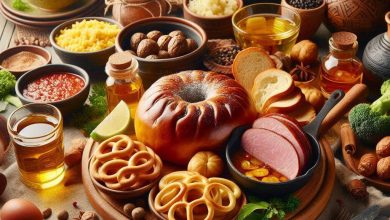Good Russian dishes and Tasty Foods

“Shchi and porridge are our food,” Vladimir Dal wrote in the dictionary “Proverbs of the Russian People” in 1853. And yet the list of national dishes is much more diverse – you can surprise both compatriots and foreign guests with recipes. On Russia Day, read about traditional soups, “wet” desserts, the main taste of Russian cuisine and serving rules in the RIA Novosti material.What foreigners don’t understand
“It is very strange!” – a frequent comment from foreigners when tasting some traditional Russian dishes.
“Foreigners say about okroshka that it tastes like a salad drenched in beer,” notes writer and historian of Russian cuisine Pavel Syutkin. “Rassolnik—a soup with pickled cucumbers—is like a foreign culinary universe for many.”
But soups are considered almost the basis of Russian cuisine.
Fish soup was often cooked, and in Russia they preferred it rich in spices, adds Syutkin.
Dried fish is a traditional Russian product. Unlike other countries, we prepare many types of fish this way and eat them separately,” says Piskunov.Porridge in the oven, morels and kundums
The main taste of Russian cuisine is sour-fermented. It is the basis of many traditional dishes, such as sour cream, black bread, fermented baked milk, kvass, lists Pavel Syutkin.

To introduce foreigners to Russian cuisine, the expert suggests putting pickles on the table – cucumbers, sauerkraut, pickled apples. For a snack – black bread with herring. After the soup, serve hot – “something with sour cream and pickles.”
Dumplings are also possible. Unlike its Chinese or Italian counterparts, in Russia it is filled with several types of meat and served with sour cream. “They used to be called “ears” or “kundums”; there were also lean ones – with mushrooms, fish, porridge,” says Syutkin. “And first they were baked on a baking sheet, then they were put in a pot and simmered in the oven under sour cream.” This technology made it possible to preserve shape, taste and juiciness.
Porridge is a common food of medieval cuisine in any European country. The special features of cooking were ensured by the Russian oven – the dish was simmered for a long time.
Contrary to beliefs, the traditional domestic drink before the advent of distillation technology was not vodka, but honey. The preparation was diluted with berry juice, fragrant herbs were added and poured into a barrel to ferment and infuse for several years.
It could be simpler: leaven, for example, bread, was added to honey. The strength of the resulting drink reached ten degrees. “It hit me in the head, but my legs refused to move,” says Syutkin.
Dessert in Russian

There were two types of desserts in Russia – “dry” and “wet”. So, Vyazemsky ones were made from almond flour, eggs and honey, they were translucent. Now the art of making gingerbread has been largely lost, explains Pavel Syutkin. They are made hard so that the pattern holds well.
They prepared dozens of types of marshmallows – with apples, berries, mint, herbs – or, for example, cookies, sweet pancakes with jam.
“Wet” sweets are those that need to be eaten with a spoon: aspic (jelly) from apples and, of course, jam.
Special serve
The list of dishes on the table was influenced by seasonality. Peasants salted cabbage in October and ate it with bread until May – until fresh vegetables appeared. In summer, mushrooms, fruits, and berries were dried.
Sometimes this was done with ready-made dishes – for example, dumplings. “They were laid out on boards and taken out into the cold,” adds Alexey Chigak.
Russian cuisine is also characterized by a special presentation of dishes.
So, in the 18th and 19th centuries, invitees gathered in the living room, where snacks and alcoholic drinks – vodka, liqueurs – were waiting for them. The fourth break consisted of roast turkeys, ducks, geese, piglets, veal, grouse, hazel grouse, and partridges. Sweets concluded the meal.




